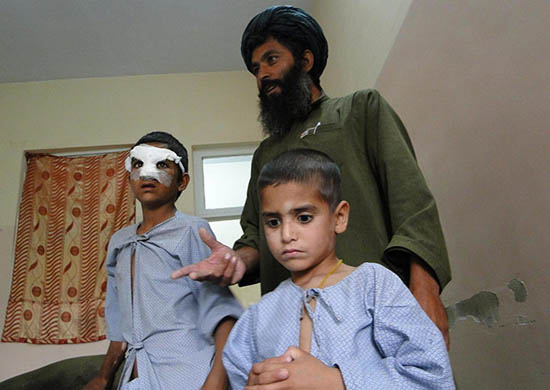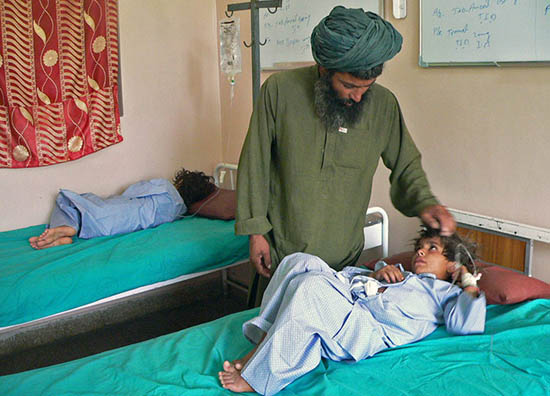Jon Boone in Kabul and Ali Safi in Kandahar

Haji Abdul Ghafar with his son Agha Shereen, left, who suffered a broken leg and nose in the alleged Nato attack, and nephew Abdul Jabar who is suffering from severe shock. (Photo: Ali Safi for the Guardian)
Survivors of an alleged Nato rocket attack on a small town in Helmand, which the Afghan government says killed 52 civilians, spoke today of their anger at what they claim was a deliberate air strike, despite coalition denials.
The incident is alleged to have taken place last Friday in Regey, in the volatile Sangin district of Helmand. News of it came as a deluge of leaked US army documents about previously unreported civilian killings threatens to ruin Nato's attempts to persuade Afghans that it takes innocent deaths seriously.
Many residents of the town say they believe the strike, which they say was a missile attack on a mud house where people were hiding from nearby fighting, was deliberate. "The foreign forces could see us," said Haji Abdul Ghafar, a 38-year-old farmer who had fled to Regey from a nearby village. "We were not in any hideouts. The Americans can see tiny things on the ground, but they could not see us. I think they bombed us on purpose."
Ghafar said at first he had not known whether shooting was coming from "tanks" or from aircraft. "But people a bit far from us said that the foreign troops' tank fired a cruise missile. It hit the house and destroyed the front of the house and the left wall."
He was speaking to the Guardian at the Mirwais hospital in Kandahar city, where he went with his son, Agha Shereen, who suffered a broken leg and nose, and a seven-year-old nephew, Abdul Jabar.
Abdul was still suffering from severe shock, appearing to believe he was still at home and looking for his sandals to go out and play with other children. In total, Ghafar said, 17 members of his extended family were killed, including three sisters, three daughters and one son.
The large number of apparent deaths could be explained by the reputation of Regey, which is bounded by two rivers, as a safe area where people can escape fighting between foreign forces and insurgents – Nato has confirmed there was fighting in a village six miles south.
"There has never been fighting in Regey because people thought that military or Taliban will not cross the river," said Haji Fazul Haq, a former governor of Sangin. "People have always thought this is the best place to be safe."
Ghafar made clear his disdain for foreign soldiers. "When Taliban fight, they always tell us to leave the area," he said. "Even before this fighting, Taliban told us to leave the area and we left."
Nato has long accepted that such incidents, including those uncovered by documents published this week by Wikileaks, cause huge damage. They have in the past caused major rows between the Afghan government and Nato.
The Afghan president, Hamid Karzai, has condemned the alleged incident in Helmand, and repeated the claim that 52 people were killed. However, yesterday his spokesman praised successful efforts by Nato to reduce civilian casualties, in part through tough restrictions on the use of force. Under rules of engagement issued last year, the alleged attack on the building in Regey should not have been allowed unless troops on the ground could clearly identify insurgents and no civilians, or had reports from at least two intelligence sources to that effect.
Nato says that so far a joint investigation with the Afghan government has not supported the villagers' claims. "The villagers took the joint team to a graveyard in Regey village and they claimed that 35 people were buried there, but the graves seemed to be old," said Dawood Ahmadi, a spokesman for the provincial governor.
"The team have not found any evidence to show that the civilians were killed," he said. "They [the villagers] may have been lying but we are there to find out."
Nato's reputation for coming clean has been damaged by past incidents when it at first denied it had done anything wrong, before later admitting large numbers of people had in fact been killed – a pattern highlighted by the Afghanistan war logs published this week in the Guardian.
One problem is that investigation teams can struggle to get to the sites of such accidents and to stay long enough to conduct a thorough investigation, particularly when they are in hostile territory. For example, when as many as 125 people were killed in September last year when a German commander ordered an air strike on kidnapped fuel tankers in the northern province of Kunduz, he urged an investigation team not to visit the area because it was too dangerous.
The Afghan government's claim of 52 dead is based on an investigation by local members of the country's intelligence service, who could well have had access to the village. The UN said it was "deeply concerned" at the reports and urged a thorough investigation.

Children recover in hospital following Nato rocket attack. An Afghan man talks to his wounded child. (PHoto: Hamed Zalmy/AFP/Getty Images)
Some of the worst civilian casualties:
July 2002 US warplane mistakenly bombs wedding party in Deh Rawud in Oruzgan province, 105 miles south of Kandahar. Up to 48 people are killed and more than 100 injured when the bomb hits a house in the village.
February 2003 At least 17 civilians killed in a US-led bombing raid in southern Afghanistan. The vVictims were living lived in villages in the Baghran district of Helmand province in southern Afghanistan, a Pashtun area where many had supported the Taliban regime.
October 2003 Province of Nuristan province – eight members of one family killed by US or allied warplanes
November 2007 US forces mistakenly kill at least a dozen road construction workers in air strikes in eastern Afghanistan. As many as 14 engineers and labourers were killed in Nuristan province. US officials blamed faulty intelligence. The workers, who had been contracted by the US military to build a road in the mountainous province, were sleeping in their tents when they were killed.
July 2008 US air strike kills 47 civilians, including 39 women and children, as they were travelling to wedding in AfghanistanNuristan.
May 2009 Farah province - nearly 100 killed in US air strikes over two days. A US investigation said 26 civilians and 78 Taliban fighters died in attacks by US bombers in the western Farah province. Afghan officials put death toll at 140.
September 2009 According to Nato, 142 insurgents and civilians killed in German air strike on two oil tankers seized by Taliban in the northern region near in Kunduz.
February 2010 Thirty-three civilians killed in Uruzgan province in Nato air strike on vehicle convoy.



